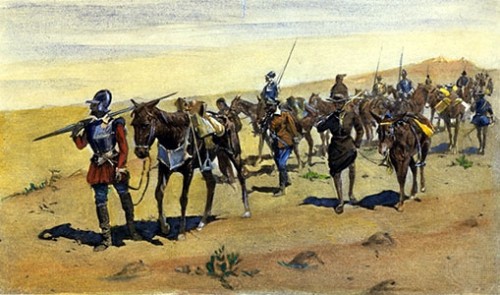Early Explorers
Based on their experiences in Mexico, the early Spanish explorers had a vision of “cities of gold” in their heads as they traveled the long road north to uncharted territory. They found none of the fabled riches, and their subsequent efforts turned to converting the Indians to Christianity. We know about their explorations through official reports made to the Spanish crown and through individual journals.

Captain Francisco de Barrionnuevo, who arrived with Francisco Vasquez de Coronado in 1540, visited seven villages in the Jemez Valley and reported that he had heard of more.
A group led by Fray Bernardo Beltran and Antonio de Espejo came into the Jemez area in 1582. They are credited with the first official use of the term la Nueva Mexico to describe the region we now call New Mexico. They encouraged the conquest and colonization of this “new” Mexico.
Don Juan de Oñate traveled up the Rio Grande and established his expedition at the site of a large pueblo in 1598, today’s Coronado Historic Site in Bernalillo, New Mexico. He founded the Province of Santa Fe de Nuevo Mexico and became its first governor. He visited the Jemez area, and his reports mention nine pueblos.
Two missions were built in the Jemez in the 1600s: San José de los Jémez at the site of a large pueblo named Guisewa and San Diego de la Congregacion at Walatowa. The mission at Guisewa was established in 1598 and then abandoned the next year. The Spanish returned to build in 1620-21.The mission consisted of a church and convento (priests’ quarters), now the ruins we see today at Jemez Historic Site. This mission was abandoned in 1630 and remained unoccupied for more than 200 years. The mission at Walatowa was destroyed in the Pueblo revolt of 1860.
In 1849, Lt. James Simpson, U.S. Corps of Topographical Engineers, traveled as far north along the river as Giusewa. In his Navajo Expedition: Journal of a Military Reconnaissance, he describes in detail the pueblo and the ruins, but makes no mention of any settlers around the hot springs. Although the purpose of the expedition was to subdue marauding Navajos, Simpson’s observations extended to farming practices of the pueblo Indians, geology and other information on the sites they visited.